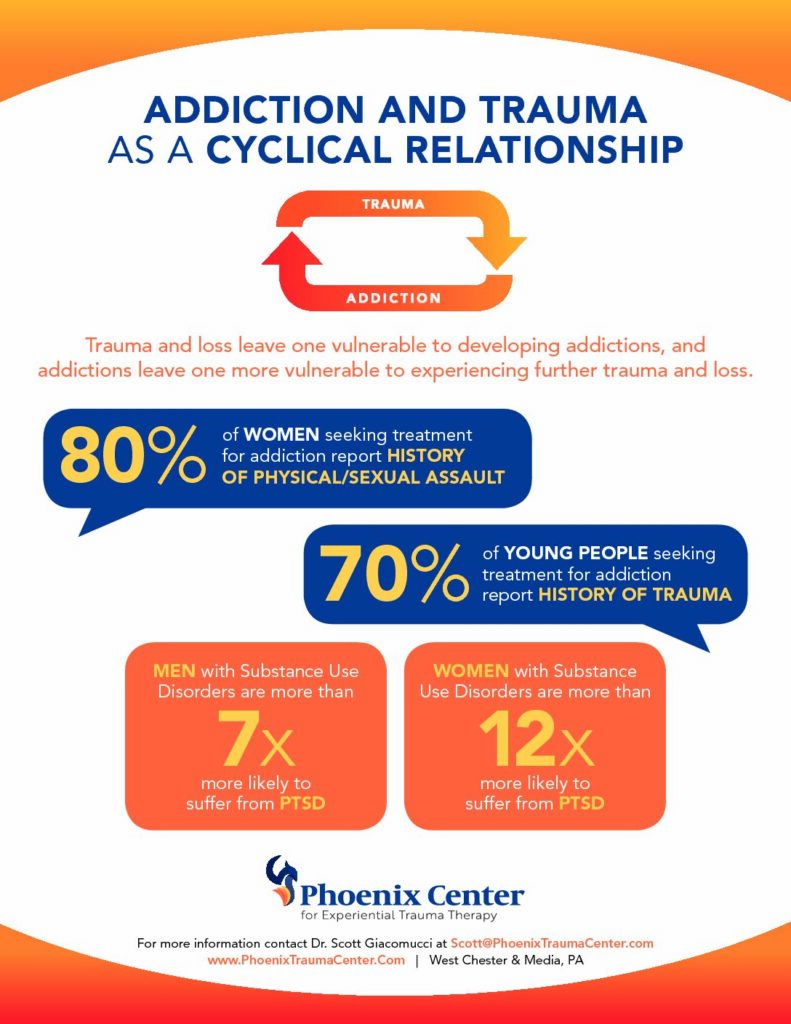Dr. Scott Giacomucci, DSW, LCSW, CTTS, CET III, PAT
“It is impossible to understand addiction without asking what relief the addict finds, or hopes to find, in the drug or the addictive behavior.” –Dr. Gabor Mate
Among the most common underlying factors of Substance Use Disorders (SUDS) and other addictive behaviors are unresolved trauma, neglect and loss. Ignoring these fundamental issues in treatment results in a focus on symptom control rather than addressing the actual causes of addiction and relapse.
Addiction and Trauma—a Cyclical Relationship
Addiction and Trauma/loss have a cyclical relationship, which means they fuel each other. Trauma and loss leave one vulnerable to developing addictions, and addictions leave one more vulnerable to experiencing further trauma and loss.
Trauma impacts our ability to regulate ourselves and our emotions, which is where the addiction comes in to play a role in helping us self-soothe and numb these emotions. Both addiction and trauma are characterized by attempts to ‘get out of ourselves’ through numbing, dissociation, and avoidance. Recent neuroscience research shows that social pain and physical pain look identical in brain scans – any opiate addict will tell you how well opiates work at numbing both types of pain. These findings further highlight the intersection between addiction, trauma, and loss.
Trauma describes any experience that overwhelms one’s ability to function and cope. An inclusive definition of trauma might include experiencing or witnessing violence (relational or collective), abuse (physical, emotional, or sexual), death or loss, neglect, and abandonment.
Research has demonstrated a strong connection between trauma and many mental health issues—including addictions, depression, and anxiety. Post-Traumatic Stress Disorder (PTSD) symptoms include intrusions, avoidance, hyperarousal, negative thought/mood states and dissociation. These could simply be described as a manifestation of past experiences (feelings, thoughts, images, relationships, physical sensations, defenses, and behaviors) showing up in the present moment.

ACE Study
Research has shown a strong correlation between adverse childhood experiences (ACEs) of trauma, neglect and loss, with adult alcoholism and addiction. The ACE study used a simple 10 yes/no questionnaire inquiring about experiences of trauma, neglect, and family dysfunction in childhood. For someone reporting four or more ACEs, the results show a 500 percent increased chance of developing adult alcoholism, and a 1300 percent increased chance of developing an addiction. Higher ACE scores were correlated with her rates of depression, suicide attempts, and other medical issues.
- 4 ACEs = 500% increase in adult alcoholism
- 4 ACEs = 1300% increase in adult IV drug use
- 6 ACEs = 4600% increase in adult IV drug use
Trauma Treatment
There are many different approaches to trauma treatment and trauma recovery. While some people find traditional talk therapy to be helpful, other therapy approaches are available and may be more suitable for trauma work. Recent neuroscience research shows that the language/speech parts of the brain are offline when one remembers a traumatic event, which supports the use of or arts-based experiential therapy approaches such as music therapy, art therapy, drama therapy, and psychodrama. In the psychodrama approach, rather than talk about an issue or problem, we can put the situation into action using role-playing techniques and practice new ways of responding. In psychodrama, we could have a dialogue with God, with a deceased loved-one, or even with yourself at a different point in time. Psychodrama allows us to go places in therapy that would be impossible otherwise.
Another highly recommended and effective treatment for trauma is ‘EMDR’ or Eye-Movement Desensitization and Reprocessing. EMDR works by first providing practical tools for dealing with stress, anxiety, and overwhelming feelings. In EMDR, we call these resources; basically, there are about accessing positive memories that can change how we are feeling currently. After the resourcing stage comes the EMDR processing stage during which specific traumatic memories are targeting using EMDR’s protocol. EMDR is incredibly effective for single-incident traumatic events. EMDR and the creative-arts therapies are unique in that you can heal from trauma without having to tell someone every detail of your traumatic experience.
To find a local psychodrama group or workshop, use www.PsychodramaCertification.org
To find a local EMDR therapist, use www.EMDRIA.org
Recommended Resources
Yoga and meditation are wonderful resources for trauma and addiction recovery. A recent study found yoga to be more helpful in reducing PTSD symptoms than any medication that has ever been researched. Research on meditation supports its effectiveness in rewiring the brain and strengthening one’s ability to tolerate discomfort, empathize with others, and find inner peace.
Suggested Books
Bessel van der Kolk, MD – The Body Keeps the Score: Brain, Mind, and Body in the Healing of Trauma (2015)
Peter A. Levine, PhD – In an Unspoken Voice: How the Body Releases Trauma and Restores Goodness (2010)
Francine Shapiro, PhD – Getting Past Your Past: Take Control of Your Life with Self-Help Techniques from EMDR Therapy (2013)
Christine A. Courtois, PhD – It’s Not You, It’s What Happened to You (2014)


Great post Scott, at my new position they are providing trauma treatment and services such as EMDR, Acupuncture, and multiple types of relaxation and meditation treatments.
Excellent post Scott. Thank you so very much for the work that you are doing for people like my son and countless others. Getting to the underlying causes of substance use disorder through trauma informed care is so vitally important to meaningful, long term recovery.
Very nice post-Scott